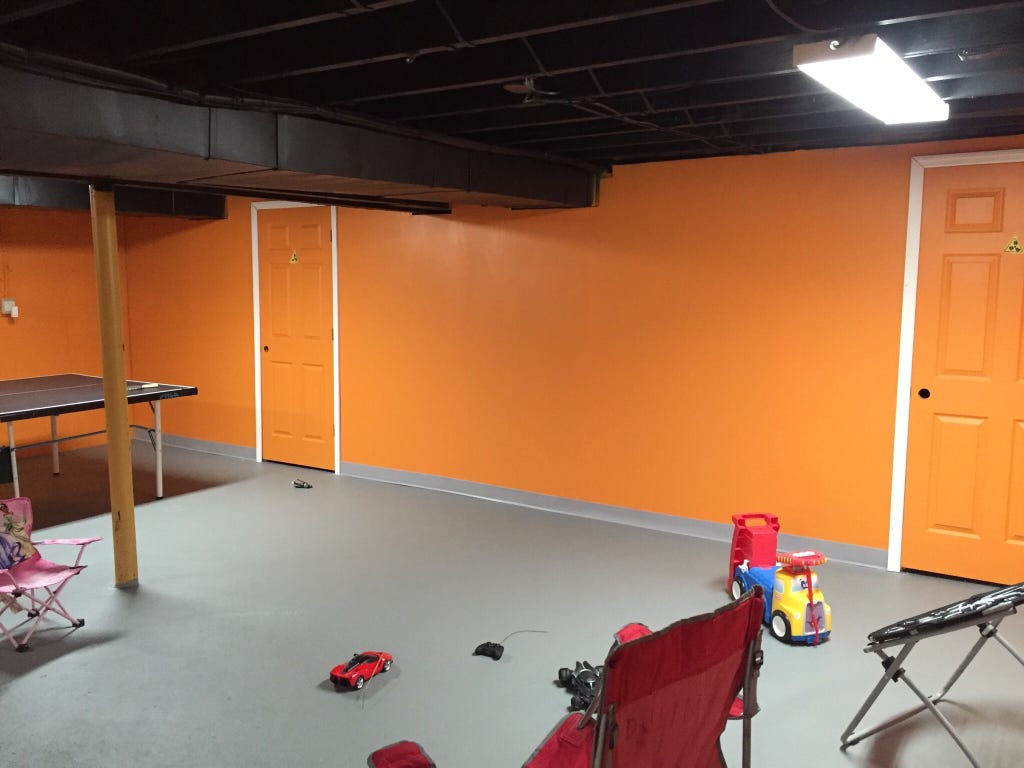I've been working on finishing my basement on and off for the past couple of years.
So far I have all the partitions I want, I built closets, etc. The floor is poured concrete slab that I painted -- and I am thinking I will not put anything else on top of it, other than maybe area rugs. The ceiling is unfinished but spray-painted black. It looks great (see photo). The ceiling will probably stay this way for some time.
At the moment, even the concrete walls are spray painted the same orange color as the drywall walls.
The slab has about a 2" gap where it meets the concrete walls. I believe this was done for drainage. The basement also has a spot for a sump pump, but we never in our almost 10 years here had a drop of water in the basement. I am not worried about moisture. Even during Sandy when the street was flooded a foot deep we didn't get a drop of water in the basement. Our house sits about six feet above the street level.
We don't have a radon problem either. When we bought the house it measure at 2.4, and I recently had it measured at 2.9. There is decent ventilation down there with automatic vents in the crawl space that close when it is below 45 degrees.
The basement doesn't have any HVAC vents either, but I do have a dehumidifier down there that I run in the summer. The system is powerful enough to handle the downstairs area and I may add some vents. It never really gets colder than 60 F in the winter or warmer than 80 F in the summer down there. The entire basement is completely underground with the exception of maybe a foot and half on top.
In any case, what I'd like to do next is finish the concrete walls. I am thinking of gluing foam board insulation to the walls first, this is in case some moisture seeps in through the walls and also to add a bit of an insulation. That will cover the drainage gap and then I will frame the walls in front of the insulation.
Is my reasoning correct? What kind of foam board insulation should I get? Which side do I attach it to the concrete walls?
Advice is greatly appreciated!
![Image]()
Sent from my iPad using Tapatalk
So far I have all the partitions I want, I built closets, etc. The floor is poured concrete slab that I painted -- and I am thinking I will not put anything else on top of it, other than maybe area rugs. The ceiling is unfinished but spray-painted black. It looks great (see photo). The ceiling will probably stay this way for some time.
At the moment, even the concrete walls are spray painted the same orange color as the drywall walls.
The slab has about a 2" gap where it meets the concrete walls. I believe this was done for drainage. The basement also has a spot for a sump pump, but we never in our almost 10 years here had a drop of water in the basement. I am not worried about moisture. Even during Sandy when the street was flooded a foot deep we didn't get a drop of water in the basement. Our house sits about six feet above the street level.
We don't have a radon problem either. When we bought the house it measure at 2.4, and I recently had it measured at 2.9. There is decent ventilation down there with automatic vents in the crawl space that close when it is below 45 degrees.
The basement doesn't have any HVAC vents either, but I do have a dehumidifier down there that I run in the summer. The system is powerful enough to handle the downstairs area and I may add some vents. It never really gets colder than 60 F in the winter or warmer than 80 F in the summer down there. The entire basement is completely underground with the exception of maybe a foot and half on top.
In any case, what I'd like to do next is finish the concrete walls. I am thinking of gluing foam board insulation to the walls first, this is in case some moisture seeps in through the walls and also to add a bit of an insulation. That will cover the drainage gap and then I will frame the walls in front of the insulation.
Is my reasoning correct? What kind of foam board insulation should I get? Which side do I attach it to the concrete walls?
Advice is greatly appreciated!

Sent from my iPad using Tapatalk




